LEMON GROVE CITY COUNCIL HOLDS CONTENTIOUS HEARING OVER TINY HOMES PROJECT FOR HOMELESS

Council fields questions and concerns regarding County’s project planned on Caltrans property
Story and photos by Karen Pearlman
March 6, 2025 (Lemon Grove) – The controversy and concerns surrounding a planned interim housing project at Troy Street and Sweetwater Road continues to drive a wedge between residents and members of the Lemon Grove City Council -- and looks to be headed for discussion in a future closed session.
San Diego County-spearheaded the temporary housing project, an $11.1 million plan to build up to 70 tiny homes for people experiencing homelessness on Caltrans-owned property in Lemon Grove. The project was the subject of a special Lemon Grove City Council meeting held March 4 at the Roberto Alvarez Auditorium.
The cabins are expected to start construction this year and be finished sometime in 2026.
The meeting included a presentation by four county staff members and brought out nearly 200 residents plus other interested individuals packing the auditorium. Some said they have been asking for the City Council to listen to their concerns and act on their behalf since last July.
First-term Lemon Grove Mayor Alysson Snow and veteran City Councilmember Jennifer Mendoza were candid about the need for housing in the city.
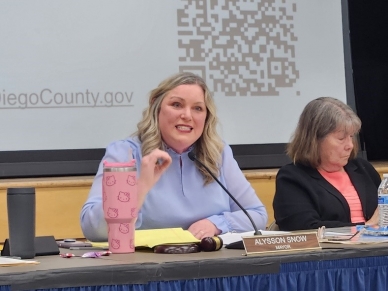 Mayor Snow (photo, right, with Councilmember Mendoza) said, “I understand that there is a population of people here in Lemon Grove who don’t want these cabins. There’s also a population of people who absolutely, desperately need these cabins... a population who really need help, and this is a big help to that.”
Mayor Snow (photo, right, with Councilmember Mendoza) said, “I understand that there is a population of people here in Lemon Grove who don’t want these cabins. There’s also a population of people who absolutely, desperately need these cabins... a population who really need help, and this is a big help to that.”
Mendoza said she has long been part of the Interfaith Shelter Network that advocates for those individuals who are homeless, and said there is a dire need for Lemon Grove to step up for those living on the street or in their vehicles.
Newly elected Lemon Grove councilmembers Jessyka Heredia and Steve Faiai as well as newly appointed councilmember Yadira Altamirano -- who previously served on the council in 2019-20 -- peppered the county staff with questions and concerns about who would be living in the homes, how they would be chosen and why their presence could impede the safety of residents.
All three said they understand the need to house those who are living on the street, but expressed interest in making unhoused Lemon Grove residents the top priority when considering who should live in the cabins—not homeless people from other areas.
 Photo, left: tiny homes in El Cajon, courtesy of Meridian Baptist Church in El Cajon
Photo, left: tiny homes in El Cajon, courtesy of Meridian Baptist Church in El Cajon
A majority of the approximately three dozen speakers shared concerns, including the close proximity of the planned cabins to a school, potentially reduced property values, a liquor store across the street and the exorbitant cost, which will also include annual charges of $3 million for ongoing operations needs.
A contingent of those opposed to the plan to house a mixture of unsheltered veterans, senior citizens, transitional aged youths and adults held little back at the nearly four-hour meeting.
Former Lemon Grove City Council member Liana LeBaron called out Snow, who defeated LeBaron in the race for mayor last year, and called the project “a money grab.”
“County officials’ intentions are to put people who are suffering from drug and alcohol addiction and severe mental health issues right next to a preschool,” LeBaron said.
LeBaron encouraged the Council to meet in closed session to take legal action against the county about the cabins “and plan a strong legal fight against the project,” and told them to “stand up for us.”
Larry Bonamo, who said he is a longtime resident of the city and who owns a Spring Valley business directly across the street from the site, said while “we all want to help the homeless,” those individuals experiencing homelessness who have mental illness and drug problems “don’t want to live by rules and regulations” and should not be in the area.
He said Spring Valley, which “turned down the project”, will be impacted the most.
Initially, the project was supposed to bring 150 sleeping cabins to Spring Valley. Objections from Spring Valley residents to the San Diego County Board of Supervisors about the location of the cabins near residences and protected sites led to the county’s decision to move the project to Lemon Grove, but with less than half the number of cabins originally planned.
Last July, Supervisors voted 4-0 to move forward on the project, with then-chair Nora Vargas absent, a vote that came two days before a previously planned community forum in Lemon Grove about the project.
Bonamo said the project “doesn’t do anything for the homeless in Spring Valley or Lemon Grove.”
“We don’t need another 70 to 140 people,” he added. “We already have enough problems here at this location. We the business people and the citizens have to deal with shopping carts, trash, fights, property they’re using as a toilet, bothering our customers, breaking into homes, breaking into cars.”
While county staff told those at the meeting that coordinated referrals and intakes into the program would be led by the county’s Office of Homeless Solutions and would exclude those with certain criminal backgrounds such as registered sex offenders, arsonists or active felony warrants, many in attendance said they didn’t believe that.
Amy Reichert, who lost a 2023 bid for county supervisor in District 4 (which encompasses Lemon Grove) to Monica Montgomery Steppe, said that residents of the city had been lied to when Snow told residents that the project would house working families and seniors.
“Cabins only accommodate two people,” Reichert said. “These... are not habitable for a family of four.”
 Four people who have been homeless or currently are experiencing homelessness spoke in favor of the cabins, including Rachel Hayes (photo, left), who said she has been “homeless for over 10 years, including in Lemon Grove and probably in every city in San Diego... and in almost every shelter in San Diego.”
Four people who have been homeless or currently are experiencing homelessness spoke in favor of the cabins, including Rachel Hayes (photo, left), who said she has been “homeless for over 10 years, including in Lemon Grove and probably in every city in San Diego... and in almost every shelter in San Diego.”
Hayes said she found housing through Alpha Project about 1½ years ago in permanent, supportive housing.
She credited the nonprofit’s wraparound services as being crucial to her ability to feel safe, then shared the importance of being able to have a home with a door that shuts.
"Not everybody out there are drug addicts or mentally ill,” Hayes said. “I support these cabins and you (elected officials) are brave to go ahead and do this. If I were on the streets, that’s where I would want to be, in one of your cabins. Because you have a door that you can close and with that door comes peace, serenity and dignity.”
A few city councilmembers and former elected officials from other jurisdictions also attended, with two speaking out about the need for compassionate care for those who are unhoused.
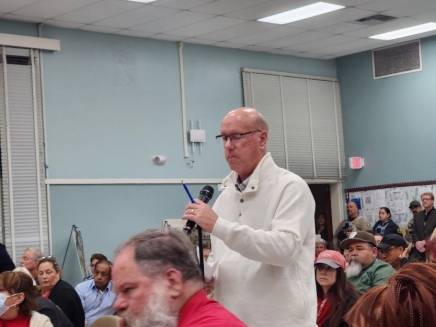 El Cajon City Councilman Steve Goble (photo, right) shared that he is proud of the success of his city’s tiny homes project, on the grounds of Meridian Baptist Church on Third Street since 2022.
El Cajon City Councilman Steve Goble (photo, right) shared that he is proud of the success of his city’s tiny homes project, on the grounds of Meridian Baptist Church on Third Street since 2022.
“Forty-two women have gone through those cabins, and 78 percent have gone on to permanent housing,” said Goble, who helped hammer nails to build those cabins.
Snow acknowledged that Lemon Grove is without shelter and without resources, and that the City needs to step up.
“We send our people who are unhoused out to (other) communities to get services,” she said.
Since 2022, the County has been exploring emergency housing options as part of the Compassionate Emergency Solutions and Pathways to Housing Implementation Plan.
The plan outlines community desire for non-congregate shelters such as sleeping cabins, safe parking and RV parking options.
The Troy Street site can host up to 70 sleeping cabins, restrooms, laundry, and onsite services, county staff said at the meeting.
Onsite services would include case management, housing navigation to permanent housing options, access to behavioral health services for those who have the needs, access to public benefits, employment or support with disability benefits, credit repair and other supportive services.

 Photo, right, by Miriam Raftery: Hatfield Creek Vineyards Owner Elaine Lyttleton
Photo, right, by Miriam Raftery: Hatfield Creek Vineyards Owner Elaine Lyttleton Anyone with information about the home burglary or the stolen items is asked to call the San Diego County Sheriff's Office at
Anyone with information about the home burglary or the stolen items is asked to call the San Diego County Sheriff's Office at 




 During the service of the warrant, 40-year-old Ross Warren was found concealed inside a wall as he attempted to hide from deputies. A firearm, pellet gun and imitation firearm were located inside the wall with Warren.
During the service of the warrant, 40-year-old Ross Warren was found concealed inside a wall as he attempted to hide from deputies. A firearm, pellet gun and imitation firearm were located inside the wall with Warren.  Warren was placed under arrest for assault with a deadly weapon, child endangerment, possessing/deploying booby traps and multiple counts of possessing/manufacturing destructive devices. He was transported and booked into the San Diego Central Jail.
Warren was placed under arrest for assault with a deadly weapon, child endangerment, possessing/deploying booby traps and multiple counts of possessing/manufacturing destructive devices. He was transported and booked into the San Diego Central Jail.  Warren's live-in girlfriend, Brenda Beltran, 38, was also arrested for obstructing/delaying a peace officer. She was cited and released.
Warren's live-in girlfriend, Brenda Beltran, 38, was also arrested for obstructing/delaying a peace officer. She was cited and released. 

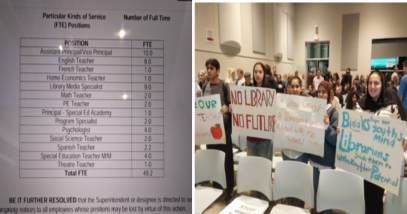 Photos, right: screenshots of an email detailing the positions to be cut, as well as protestors at the facility
Photos, right: screenshots of an email detailing the positions to be cut, as well as protestors at the facility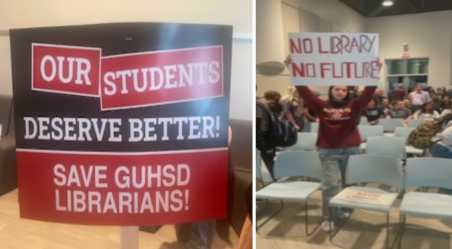 Photos, left: screenshots of posters and protesters from the beginning and ending of the meeting.
Photos, left: screenshots of posters and protesters from the beginning and ending of the meeting.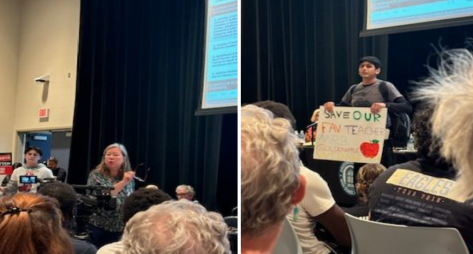 Photos, right: Rachel McCurry [left] and an unnamed student protesting the librarian cuts, who also referenced the importance of support following “two bloody shooting events” the GUHSD had two mass shootings in the past at Santana and Granite HIlls high schools.
Photos, right: Rachel McCurry [left] and an unnamed student protesting the librarian cuts, who also referenced the importance of support following “two bloody shooting events” the GUHSD had two mass shootings in the past at Santana and Granite HIlls high schools. Photos: left: the audience reacting to the Governing Board Proposal—Right: The Governing Board Chris Fite, Jim Kelly, Scott Eckert, Robert Shield and Dr. Gary Woods visible.
Photos: left: the audience reacting to the Governing Board Proposal—Right: The Governing Board Chris Fite, Jim Kelly, Scott Eckert, Robert Shield and Dr. Gary Woods visible.
 One of the documents said that the sweeping cuts to foreign aid promise to reignite outbreaks of preventable, deadly illnesses; fuel instability in war-torn areas; and put the U.S. at risk for outbreaks of infectious disease. “This will no doubt result in preventable death, destabilization, and threats to national security on a massive scale,” it says.
One of the documents said that the sweeping cuts to foreign aid promise to reignite outbreaks of preventable, deadly illnesses; fuel instability in war-torn areas; and put the U.S. at risk for outbreaks of infectious disease. “This will no doubt result in preventable death, destabilization, and threats to national security on a massive scale,” it says.